Fostering an animal is an incredibly rewarding experience that any animal lover should consider if they can. Fostering a pet simply means you’ll be providing short-term accommodation for a rescued pet until a permanent home can be found. It’s a beautiful, kind, and rewarding experience, and best of all, fostering one animal means you’re freeing up space in the shelter for other animals to be taken care of.
When you’re fostering a pet, you’re temporarily taking in an animal that’s most likely reached its last chance for a good life, or for any life at all. These pets may be traumatised by the change – they may have lost their companion, or never really had one – and you can offer them a home filled with love and affection. Fostering a pet can help prevent behavioural problems from developing due to their abandoned and often lonely past, giving animals a fresh start in life. While it’s a wonderfully generous and caring gesture to open your home to a rescue pet, it should be said that there’s a lot to consider before making the decision.
Pets who are traumatised, confused, or come from difficult backgrounds need to be brought into your home in an appropriate manner to avoid issues and potentially damaging the relationship irreparably. Here are some tips to help you ease the transition for that potentially scared and nervous animal. This is Part 2 of our Rescue Pet Foster Care Series. You can check out Part 1 here.
Before you bring a pet home
Before the pet even enters your home, there are some things you should do to make sure you’re ready for its arrival. First off, make sure you have everything you need ahead of time to avoid having to rush out on the first day. This includes:
- Leashes,
- Collars,
- Bowls,
- Litter,
- Sleeping space (bed)
- Food,
- Toys,
- Anything else that the animal might need.
It’s a good idea to ask the shelter for everything you may need. Sometimes they will provide some items, but not always everything, so it’s best to be prepared.
You should know ahead of time what section of the house the animal will spend most of their time in. Since it’s likely that they might be feeling scared and lonely, it’s a good idea to plan for their sleep spot to be somewhere near you. This could be a place in your bedroom or a bed on the floor. You should try to keep the pet in a place with an easy-to-clean floor while you’re out; these animals can be nervous in the beginning, or may not have been house-trained.
The kitchen is usually a good sleeping spot for most pets. That said, you should plan on actually being home for the first few days to help the pet acclimatise to you and your home. Your whole house should be pet-proofed against anything dangerous or valuable. Make sure food and toxic substances are out of reach.
You should also decide on a schedule for the pet ahead of time, including feeding and exercise times. Dogs especially need and thrive on structure and exercise. This schedule can change as needs arise, but it’s good to have a general idea of how the animal’s day will go at the start.
The first day
Bring your animal straight home, without stopping for errands or visits along the way. They’ll be nervous enough without that extra time spent in the car. Once you’re home, it’s a good idea to have your family meet the pet outside, where there’s more neutral ground.
When you go inside, make sure the atmosphere is calm and inviting while giving the pet a tour of your house. For a cat, you could simply let it roam on its own for awhile and gather its bearings. Show them the toilet early on, and if they go, give them a treat. But even if the animal is successful the first time, be prepared for accidents in the early days as they can still be nervous, confused and excited.
If you have other pets in the house, try to keep them separate for a little while, and try not to leave them alone together for the first few days until you’re certain that it’s absolutely safe.
As time goes on
The progress of acclimatising a foster pet to your family may take some time. These animals can come from difficult situations at times, and may not be used to routines and discipline. Try to take lots of walks to keep the pet moving, and keep them engaged and entertained with scheduled play-time. Try to keep these activities to as regular of a schedule as possible while the pet is staying in your home.
Since these animals may have been abused in the past, it’s important to always act towards them positively, to hopefully renew the animal’s trust in humans. One of the most important things to remember is to be patient. You’re caring for an animal in need, and also preparing that animal for their eventual forever home. It’ll take time for them to get used to having a home and family, and by being a foster parent you’re helping to bridge that gap so that they can approach their new family feeling loved.
It’s an unbelievable feeling to watch a rescue animal grow and develop and find their forever home. Getting off to a good start is vital to make it a reality for any rescued foster pet. Stay tuned for Part 3 of our Rescue Pet Foster Series, or have a look at our Pet Rescue Partners if you’re keen to look further into fostering a pet.







Leave A Comment